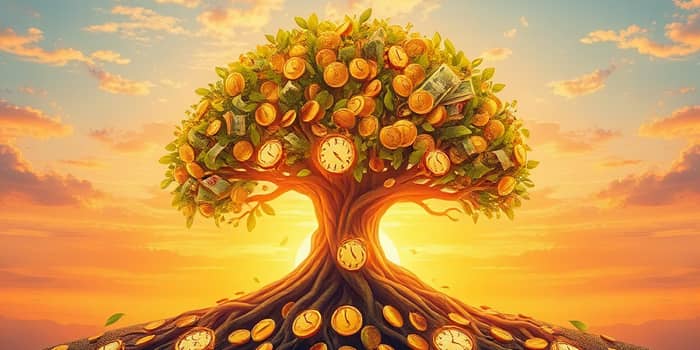
Imagine planting a seed that multiplies itself, season after season, bearing greater fruit each year. That seed is compound interest, the force that has built fortunes, secured retirements, and transformed modest savers into financial victors. This article will guide you through its magic, reveal strategies to harness it, and inspire you to plant your own financial seed today.
With vivid examples, practical steps, and clear explanations, you’ll discover why compound interest is often called the eighth wonder of the world and how you can tap into its power to grow lasting wealth.
At its heart, compound interest is interest calculated on accumulated interest. Unlike simple interest—which only applies to your original principal—compound interest credits you for past gains, creating a snowball effect of exponential expansion.
Mathematically, the formula reads:
A = P(1 + r/n)n·t,
where A is the final amount, P the principal, r the annual rate (decimal), n the number of compounding periods per year, and t the years invested.
Consider a $1,000 deposit at a 10% annual rate. With simple interest, Year 1 yields $100, Year 2 another $100, totaling $1,200 after two years. In contrast, compound interest awards $100 in Year 1, then $110 in Year 2—because that second $100 earns interest itself—bringing you to $1,210.
Increasing the compounding frequency amplifies growth further. Monthly compounding at 5% for 10 years turns $1,000 into $1,647.01 instead of $1,628.89 with annual compounding.
For regular contributions, the formula adapts to:
M’ = M((1 + r)t–1)/r + P(1 + r)t,
where M is your monthly deposit. This approach rewards consistent, disciplined reinvestment approach and accelerates your path to wealth.
Time is the catalyst that transforms small sums into significant fortunes. A monthly investment of $100 from ages 25 to 65 at an average 7% return can grow to over $190,000—even though you contributed just $48,000.
Waiting until age 35 to start would require far larger deposits to reach the same goal. That’s why experts insist time is the most powerful variable in any compounding equation. Every year you delay means lost years of exponential growth that no amount of catch-up can fully recoup.
Below is a side-by-side illustration of early versus late investment, showing how compounding can be your greatest asset when given time to work.
Higher-return assets like stocks and real estate offer robust long-term compounding but come with greater volatility. Lower-risk vehicles—such as CDs, bonds, and high-yield savings—deliver steadier, if slower, growth.
Successful investors build portfolios that match their time horizon and risk tolerance, allowing compounding to work uninterrupted across different market conditions. Remember, consistent reinvestment multiplies returns and smooths the journey toward your objectives.
Many savers delay their first deposits, underestimating the cumulative power of small early gains. Others withdraw interest or chase high-yield but high-fee products, disrupting the compounding process.
On the flip side, debt can compound against you. Credit card balances and unpaid loans grow faster than many investments, so attacking high-interest liabilities first is essential for financial freedom.
Compound interest is more than a formula—it’s a mindset. By committing to small, regular contributions, embracing patience, and leveraging time, you wield a financial force capable of transcending economic cycles and market swings.
Your journey starts now. Plant your seed, nurture it with consistent action, and watch as exponential growth over time transforms your financial future into a legacy of abundance.
References





